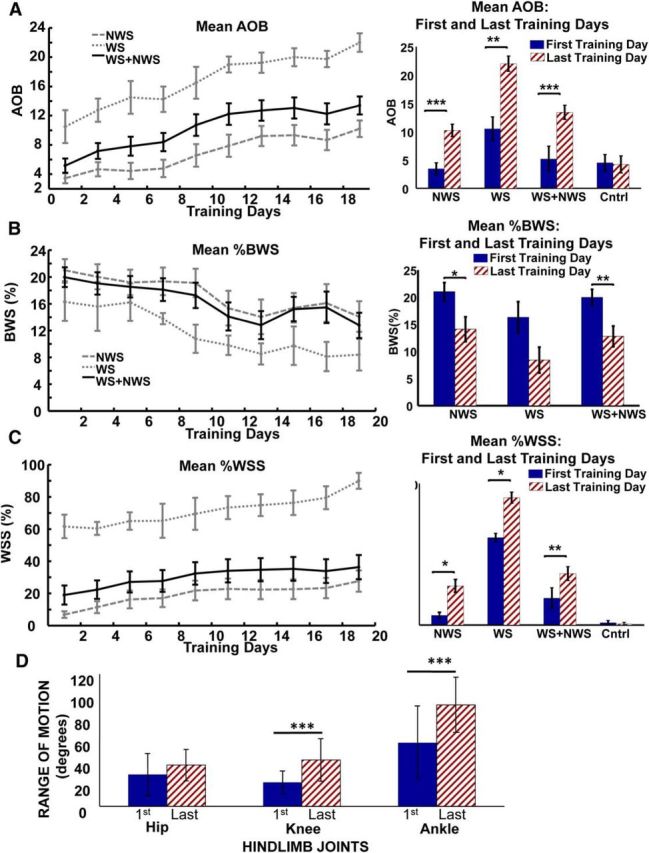Figure 2.

Significant improvement in hindlimb motor performance (AOB score), reduction of body weight support provided by robotic assistance (%BWS), increase in proportion of autonomous weight-supported hindlimb stepping (%WSS) in the NWS group of 14 adult rats spinalized as neonates (NTX rats) and WS group of 4 NTX rats, as well as the two groups combined (NWS + WS) as 18 NTX rats following robotic rehabilitation training (trunk impedance sensorimotor treadmill training). A, Mean ± SE plot of AOB scores for the NWS group, WS group, and combined group over the course of robot rehabilitation training (left), and bar plot (mean ± SE) showing post hoc comparison of AOB scores between the first and last day of training for the same NWS, WS, and combined groups, as well as the control group of 7 matched treadmill only-trained NTX rats (right). Day 1 is considered the first day of training and day 19 is the last day of training. B, Mean ± SE plot of %BWS for the NWS group, WS group, and combined group over the course of robot rehabilitation training (left), and bar plot showing post hoc comparison of %BWS between the first and last day of training for the NWS group, WS group, and combined group (right). Control rats shown in A, C had no robot training and thus were not tested in this way. C, Mean ± SE plot of %WSS for the NWS group, WS group, and combined group over the course of robot rehabilitation training (left), and bar plot showing post hoc comparison of %WSS between the first and last day of training for the same NWS, WS, and combined groups, as well as the control group of 7 matched treadmill only-trained NTX rats (right). Significant trends (R2 > 0.80, ***p < 0.001) of improved performance were observed in the AOB scores, %BWS, and %WSS for the NWS, WS, and combined (NWS + WS) groups over the course of training. The mean AOB, %BWS, and %WSS performances on the last day of training were significantly better than the first day of training for the NWS and for the combined group. ***p < 0.001. **p < 0.01. *p < 0.05. However, although improvements were seen in the %BWS for the WS group, only the AOB and %WSS performances on the last day of training were significantly better than the first day of training. D, Bar plots showing comparison of Range of Motion (ROM) of the hip, knee, and ankle joints during treadmill gait between the first and last day of training for subset of 6 NTX rats. There was a clear effect of training (two-way repeated-measures ANOVA, ***p < 0.001) on the increases seen in the ROM of the hip, knee, and ankle joints. Post hoc tests showed that the increases in ROM were significant in knee and ankle joints (***p < 0.001 for both) but not in hip ROM with the number of rats tested.
